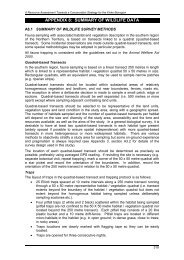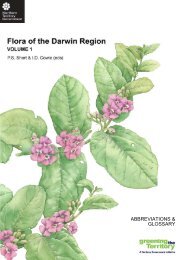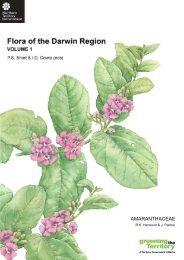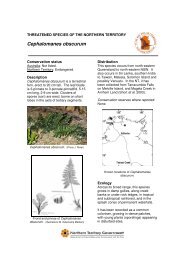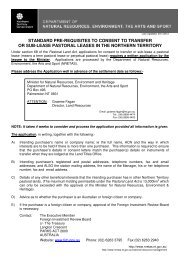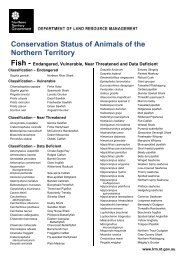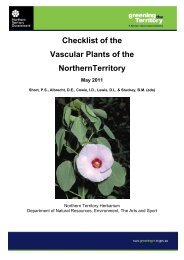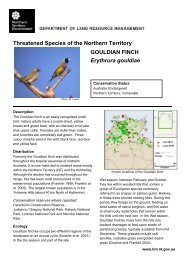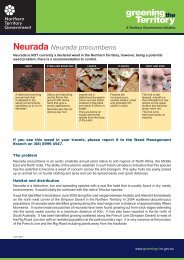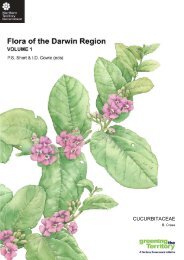ferns and allied plants - Department of Land Resource Management ...
ferns and allied plants - Department of Land Resource Management ...
ferns and allied plants - Department of Land Resource Management ...
You also want an ePaper? Increase the reach of your titles
YUMPU automatically turns print PDFs into web optimized ePapers that Google loves.
2<br />
FERNS <strong>and</strong> ALLIED PLANTS<br />
DIVISION LYCOPODIOPHYTA<br />
Plants vascular, epiphytic or terrestrial, homosporous or heterosporous. Sporophyte conspicuous;<br />
true roots present; stem short or elongate <strong>and</strong> laterally or dichotomously branched, commonly<br />
photosynthetic; spores in sporangia in the axils <strong>of</strong> leaves, the leaves sometimes differentiated into<br />
sporophylls <strong>and</strong> sometimes forming strobili. Gametophyte very small, surface-living or subterranean,<br />
sometimes photosynthetic but commonly lacking chlorophyll.<br />
Cosmopolitan, containing three families.<br />
KEY TO FAMILIES<br />
1 Leaves linear <strong>and</strong> grass-like ......................................................................................... Isoetaceae (p. 2)<br />
1: Leaves small but numerous on weak to erect stems; sporangia in the axis<br />
<strong>of</strong> sporophylls which are aggregated to form cone-like structures ...................... 2<br />
2 Sporangia <strong>of</strong> only one kind; leaf bases lacking a ligule ........................................... Lycopodiaceae (p. 3)<br />
2: Sporangia <strong>of</strong> two size classes; leaf bases with a minute ligule (but <strong>of</strong>ten<br />
difficult to seen in adult <strong>plants</strong>) .................................................................................. Selaginellaceae (p. 5)<br />
ISOETACEAE<br />
P.S. Short<br />
Plants aquatic or amphibious, heterosporous, with a swollen corm. Roots dichotomously branched.<br />
Leaves simple, ligulate, crowded into a tuft at the apex <strong>of</strong> the corm, basally dilated <strong>and</strong> with most leaves<br />
acting as sporophylls. Sporangia solitary, <strong>of</strong> two types (megasporangia <strong>and</strong> microsporangia) <strong>and</strong> borne in<br />
the basal cavity formed on the inner surface <strong>of</strong> the leaves. Spores <strong>of</strong> two types (megaspores <strong>and</strong><br />
microspores), smooth or sculptured. Gametophytes minute <strong>and</strong> protruding from spores.<br />
A family containing perhaps two genera, Isoetes <strong>and</strong> Stylites, with only the former in Australia. Stylites<br />
Amstutz (two species) is a South American genus differing from Isoetes (upon which the brief family<br />
description is based) by having elongate stems <strong>and</strong> unbranched roots. It is not always recognised as a<br />
distinct genus.<br />
Taxonomic references: Andrews (1990); Chinnock (1998a).<br />
ISOETES L.<br />
Perennial or annual, grass-like <strong>plants</strong>, the corm 2–5-lobed, the roots arising from between the lobes,<br />
roots forked towards the tips. Leaves mostly sporophyllous, spirally arranged, erect, filiform or linear but<br />
with dilated bases, 1-veined. Sporangia naked or partly or wholly covered by a velum, spores released by<br />
decay <strong>of</strong> sporangial walls. Megasporangia borne on outer leaves; megaspores c. 0.3–0.5 mm diam., white<br />
or grey, ornamented. Microsporangia borne on inner leaves; microspores minute. Quillworts.<br />
A widespread genus <strong>of</strong> c. 100 species, with 15 recognised in Australia <strong>and</strong> three in the N.T.<br />
Megasporangia contain almost spherical, nucleate <strong>and</strong> mostly fertile megaspores <strong>and</strong> also enucleate,<br />
infertile megaspores. The latter are variably flattened <strong>and</strong> triangular in outline. Dumb-bell shaped<br />
megaspores may also occur but are not described in the following descriptions. The distal face is the<br />
large, half-spheroid part <strong>of</strong> the spore, the proximal faces are the three, somewhat triangular faces.<br />
Taxonomic references: Marsden (1976a, b); Chinnock (1998a).<br />
FDRV1 March 2011



